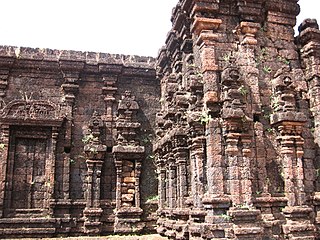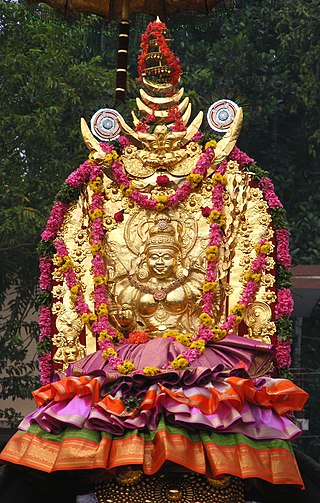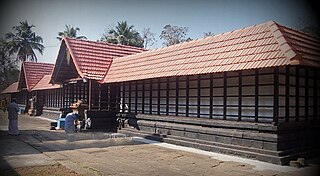
Jagannatha is a deity worshipped in regional Hindu traditions in India as part of a triad along with his (Krishna's) brother Balabhadra, and sister, Subhadra. Jagannath, within Odia Hinduism, is the supreme god, Purushottama, and the Para Brahman. To most Vaishnava Hindus, particularly the Krishnaites, Jagannath is a form of Krishna, sometimes as the avatar of Vishnu. To some Shaiva and Shakta Hindus, he is a symmetry-filled tantric form of Bhairava, a fierce manifestation of Shiva associated with annihilation.
Kunnathur Padi is the historic center for the folk Hindu deity Sree Muthappan. The center stands in Payyavoor Grama Panchayat, Kannur District of the Kerala state of India, 3,000 feet above sea level, on top of Udumbumala in the Sahyadri mountains. The region belonged to the kingdom of the Mannanar dynasty, the line of Muttappan. In 1902, Kunhikelapan Mannanar, the last king of this dynasty of Muthappan's clan, was killed and the British government seized the property of this dynasty, and Karakattidam Nayanar, a Nair landlord, got the right to manage Kunnathur Padi.

The Rajarajeshwara temple is a Shiva temple located in Taliparamba in Kannur district of Kerala State of India. The temple is regarded as one of the existing 108 ancient Shiva Temples of ancient Kerala. It also has a prominent place amongst the numerous Shiva temples in South India. It had the tallest shikhara amongst the temples of its time. The Rajarajeshwara temple has a top of about 90 tonnes. If any problem is encountered in the other temples of South India, devotees seek a solution in this temple through a prashnam, a traditional method of astrological decision-making. The prashnam is conducted on a peedha outside the temple.

Kumaranalloor is a suburb of Kottayam city, Kottayam taluk, Kerala, India. Kottayam city is just 5 km south of Kumaranalloor. The region was administered by the Kumaranallur grama panchayath till 2010, before the local self-governing body was merged into the Kottayam municipality. The former Panchayath office now exists as the regional administrative office for the municipality. The village is situated on the banks of Meenachil river.
Odanad was a feudal state in late medieval Kerala. It was established in the 11th century, and disestablished in 1746 when it became part of Travancore after Venad King Marthanda Varma's northern expedition. The last king of Odanad was King Kotha Varma. At the time of its dissolution, it was composed of the present-day taluks of Mavelikkara, Karthikapally, Chenganur in the Alappuzha district and Karunagapally in the Kollam district. Another name of onattukara is kayamkulam. In the 15th century, the capital of Odanad was moved from Kandiyoor-Muttom to Eruva and Krishnapuram in Kayamkulam, which led to the state being called Kayamkulam. After this shift, Kayamkulam became the commercial centre of Odanad, while Mavelikkara remained its cultural centre. Odanad was controlled by Nair lords, among whom the ruler of Kayamkulam was the most prominent.
Olarikkara, usually called Olari, is an important gateway to Thrissur city of Kerala state, South India. It is a major residential area in the city. It is 5 km away from Thrissur city. Several Hospitals, Temples and Churches are situated here. One of the E.S.I Hospitals of the city is here. Like all the places in Thrissur, it has very good bus facilities. Olari is Ward 46 of Thrissur Municipal Corporation.

The Vilwadrinatha Temple is a Hindu temple in Thiruvilwamala, a town in the city of Thrissur, Kerala, India. The principal deities are Rama, the seventh incarnation of the god Vishnu, and his brother, Lakshmana. It figures among the Abhimana Kshetrams in Vaishnavite traditions. This is one of the four major Rama temples in Kerala — the other three are in Thriprayar, Kadavallur, and Thiruvangad. The temple houses an idol of Lakshmana, which is rare in India. Vilwadrinatha Temple is located in the centre of the community of Thiruvilwamala, atop a 100-foot-high hillock. Visible from the temple is Bharathappuzha, the second-largest river in Kerala, which flows past the temple's northern side from around 3 kilometres away.

Anandavalleeswaram Sri Mahadevar Temple in Kollam city is one of the ancient Hindu temples in Kerala, India. Lord Siva and Goddess Anandavally are the main deities of the temple. According to folklore, sage Parashurama has installed the idol of Lord Shiva. The temple is a part of the 108 famous Shiva temples in Kerala. It is located at Anandavalleeswaram, a major neighborhood of Kollam city, that comes to the west side of Kollam Collectorate.

Thumpamon Vadakkumnatha Temple is an ancient temple near Pandalam in Pathanamthitta in Kerala, India. This temple has two Sreekovils. Both Sreekovils are round (vatta). It is an age old temple whispering several fascinating legends of the bygone eras.

Krishnapuram is a village in Alappuzha district in the Indian state of Kerala.
Thalappalam is a village in Kottayam district in the state of Kerala, India.

Perunna Subrahmanya Swami Temple is a Hindu temple located at Perunna neighbourhood in Changanacherry. The deity of the temple is Subrahmanya Swami (Kartikeya), one of the three sons of Lord Shiva. Lord Krishna, Lord Shiva, Lord Ayyappan, Mahaganapathi, Sarpa Deva, Rakshasa are other deities in this temple. This temple is famous for its 'Pallivetta' utsav.

Sri Vasudevapuram Temple is one of three ancient temples (Maha-Kshetram) on the Southern bank of holy river Bharathapuzha. It sits east of the other two, Maha-Shiva Temple and Brahma temple. These temples along with the famous Thirunavaya Maha-Vishnu temple across the river form the trilogy in Sanatana Dharma). Tavanur is called Muvaankara (മൂവ്വാങ്കര). Brahma, Vishnu, and Shiva are the presiding deities, so it was initially known as Muvalankara, and then Muvaankara. Vasudevapuram Tavanur is situated in the middle of a wooded area resembling that of Sabarimala.

Ettumanoor Mahadeva temple is an ancient Shiva temple in Kottayam, Kerala, India. The temple is one of the major Shiva temples in Kerala, along with Vaikom Temple, Kaduthruthy Mahadeva Temple, Chengannur Mahadeva Temple, Vazhappally Maha Siva Temple, Ernakulam Shiva Temple, Vadakkunathan temple and Sreekanteswaram Mahadeva Temple, Thiruvananthapuram.
Pazhaya Sreekanteswaram Temple or Old Sreekanteswaram Temple, located at Puthenchantha in Thiruvananthapuram, is one of the ancient Shiva temples in Kerala. According to the renowned historian Elamkulam Kunjan Pillai, this temple existed even in the 9th century AD. This temple is the original abode of the Lord of new Sreekanteswaram Mahadeva Temple. The new temple is situated just outside the "North Fort" in Thiruvananthapuram. As noted by Dr. M. G. Sasibhooshan, the old temple was on the route taken by the King of Travancore and his retinue in connection with the Pallivetta of the Sri Padmanabhaswamy Temple.

Thuravoor is a gram panchayat in the Pattanakkad Block of Cherthala Taluk of the Alappuzha District, State of Kerala, India. It comes under Aroor Assembly constituency. Thuravoor lies under Kochi UA in future. A four lane(six lane is progressing) National Highway 66 passes through the village, which along with a railway station gives it excellent connectivity with the remainder of the state. The new 6 lane elevated highway is from Thuravoor to Aroor. Upon completion, it will become the longest elevated highway in the country. Thuravoor is a rapid developing town. It lies in Aroor Assembly constituency. Thuravoor Kumbalangi road is a main road parallel to NH 66. Thuravoor is the major entry to Kochi city.

Anikkattilammakshethram is a Hindu Temple situated in Anicadu Village, 3.5 km from Mallappally in Pathanamthitta district in the southern part of Kerala, in the peninsular India.
The town of Muvattupuzha in Kerala, India contains places of worship for Hindus, Syrian Christians and Rawther Muslims.
This is a list of ancient Buddhist sites, relics, traditions and places from the Indian state of Kerala. Even though Kerala does not have any major presence of Buddhists in modern times, many historians recognize a Buddhist heritage that seem to have existed until the 10th century CE along with a widespread Sramana tradition of co-existence between Buddhism, Jainism and ancient Dravidian folk religion.

Parumala Valiya Panayannarkavu Devi Temple is an ancient Hindu temple dedicated to Sri Badrakali and Lord Shiva, situated on the banks of the Pampa river at Parumala of Pathanamthitta District in Kerala state in India. The Panaynararkavu Temple is one of the three most important Bhadrakali temples in Kerala. Thirumandhamkunnu Temple in Malabar, Kodungallur Temple in Cochin and Panayannarkavu Temple in Travancore is almost equally important. References to this temple are found in Aithihyamala of Kottarathil Sankunni and Unnuneeli Sandesam, the classics of Malayalam Literature. According to folklore, sage Parashurama has installed the idol of Lord Shiva and devi idol installed by sage Durvasa and Narada in the Treta Yuga. The temple is a part of the 108 famous Shiva temples in Kerala.













